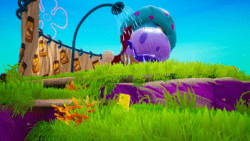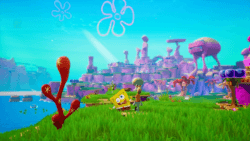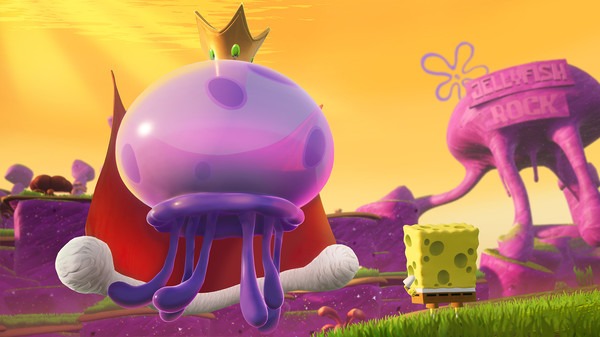‘SpongeBob SquarePants: Battle for Bikini Bottom – Rehydrated’ review
As I sit in my flat, baking and parched, I feel like SpongeBob when he was in Sandy’s waterless dome; a husk, eyes red and dry, skin taut and itchy. In the time I’ve been waiting for The Last of Us to come out, I’ve felt devoid of any exciting games to play and had hoped SpongeBob would quench that thirst. Instead, it just had me wanting to play other platformers of the original game’s era.
I have never played the original Battle for Bikini Bottom, so this was a great chance for me to dive into what many friends remember as a childhood classic. I have always enjoyed SpongeBob, and though I know the show enough to recognise most of the characters and memes, I wouldn’t call myself a diehard fan. I feel like this is a good place for me to be in terms of reviewing the game; familiar enough to get the content, but not so obsessed I let nostalgia cloud my judgement.
It felt wonderful exploring the world of the show, especially with most of the original voice actors reprising their roles (with the notable exception of Mr Krabs). The characters are (mostly) rendered amazingly, with varied and comical facial expressions. SpongeBob does appear luminously bright compared to his companions though, which can be a bit of an eyesore at times.

Feels wrong to attack someone at their most vulnerable… Even a boss.
There are random Bikini Bottom residents scattered throughout levels and though some talk, many just walk a set path and don’t even react when you hit them. I think this was a missed opportunity for some additional dialogue and interactions, and this is part of what makes this game feel like a remaster, not a remake.
The objectives are simple: collect golden spatulas and socks and stop the robot menace Plankton has set loose upon the town. The humour is consistently silly and a bit absurd, just as it is in the show. It’s great seeing SpongeBob interact with characters like Squidward and Barnacle Boy, and this is where the game’s childish sensibilities really shine.
Though the game is funny, the story feels incredibly loose. Each level is made up of a few side quests that reward you with spatulas, and little secrets or hard to reach areas that give socks, but the narrative feels pushed to the side. Yes, you’re always fighting robots, but the importance of what Plankton has done is barely re-stressed. Compared to games like Ratchet and Clank or Sly Cooper, SpongeBob’s story feels weak and uninvolved: simply a vehicle to push you to play more levels.
The levels are bright and fun, if not particularly challenging. There is certainly some scaling difficulty, but nothing too severe. The movement is good, and the enemy types are varied enough to stop the gameplay feeling repetitive. The main problem I encountered with controls was when trying to smash moving boxes while bungee jumping from SpongeBob’s wedgie. This was finicky and seemingly based on random chance, leaving me longing for the coherent and responsive controls of Crash Bandicoot or the Jak series.
If you are desperate to return to what was, for you, a childhood classic, then you likely won’t be disappointed
The three playable characters encourage retrying levels once new abilities are unlocked. What should be a fun and quick swap is marred by the odd necessity of sparsely-placed bus stops that are required to switch. While it may remain true to the original, it is an area where a remake could afford a quality of life change that allows players to swap characters with a button press rather than this obtuse bus-stop system.
The golden spatulas are marked in each level’s objectives and you can teleport to their rough location, but the same cannot be said for Patrick’s socks. You always start the levels as SpongeBob, so you then have to walk through until you find a bus stop, swap, then walk back to the beginning and all through the level looking for any spots where a unique ability is needed.
The changing and backtracking was so annoying I found myself wishing for A Sonic Adventure system wherein each level is character-specific. The character swapping could be a very good touch, but as it currently stands, it adds too much unnecessary busywork.

Annoying Squidward will always be fun
The need for exploration is highlighted early on but is oddly punished if the player dares to step foot in an area deemed out of bounds. Often, there is no visual way to distinguish a part of the intended level from the background. The first time a human hand picked me up and plonked me back on the stage I found it funny but, when I tried to walk on a beach to destroy a cannon and was forcibly removed, I was left puzzled as to why this perfectly normal-looking beach was deemed unworthy of my footprints. Add to this the fact that all enemies respawn every time you die or step out of bounds, removing any chance you have of instantly knowing where you have and have not explored, and traipsing through the whole level several times over becomes a huge chore.
This was my first foray into the bright depths of Bikini Bottom, and while I generally did find the game fun, there are too many dated elements left over. The bosses were by far the best part of the game for me, but even they are few and far between, with many not appearing at the end of main game areas like most platformers, but in a single fighting arena.
From what I’ve seen of the original, this game remains faithful to its predecessor, but at the detriment of player experience. If you are desperate to return to what was, for you, a childhood classic, then you likely won’t be disappointed. If you’re looking for a solid platforming remake, your money would be better spent on the N. Sane Trilogy or any of the other games mentioned in this article.
Review Code courtesy of THQ Nordic

Comments